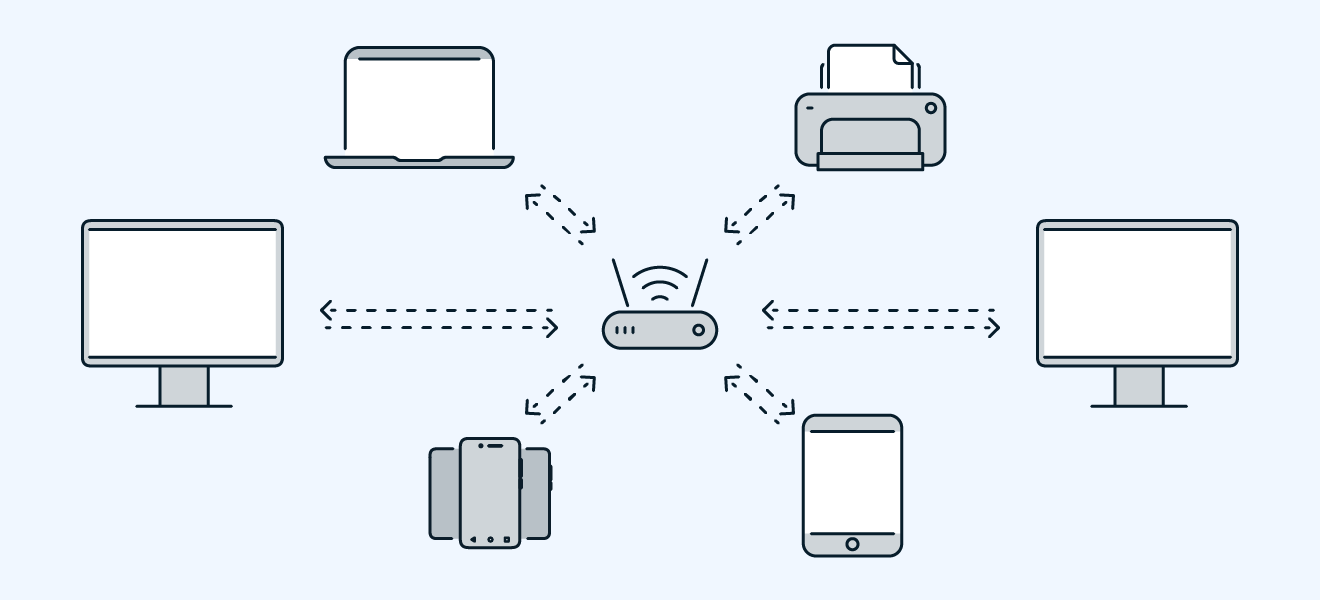What is a LAN?
LAN stands for Local Area Network, and the definition is a group of devices in the same geographical location (your home, your office, or your local cafe) that are interconnected and able to talk to one another.
Some LANs can be very large, consisting of many thousands of devices. But unlike WANs (wide area networks) or MANs (metropolitan area networks), LAN technologies are always centered on a single physical location, enabling devices at home or in the workplace to share information with one another and other networks faster and more securely.
How do LANs work?
LANs work by connecting your devices through one central router and network. Think of devices like computers, printers, and phones as destinations and the network as the roads that connect these destinations.
Your router takes care of your home LAN and may use Ethernet and/or Wi-Fi to connect devices. Some organizations set up multiple LANs as a way to manage access between departments. They may use one or more routers or network switches to allow efficient and secure packet delivery between Ethernet local area networks.
 A Local Area Network with multiple devices connected.
A Local Area Network with multiple devices connected.
What components make up a LAN?
For LANs to work and allow devices to communicate with one another, many different components are required. Each device on your network has a NIC or Network Interface Card that allows your device to address other devices with NICS and, in turn, be addressed by them. Other components that can make up a LAN include:
-
Switches or Access Points for connecting devices physically or wirelessly
-
Routers for external network communication
-
Firewalls to stop intruders from other networks from accessing your LAN
-
Signal Repeaters to extend Wi-Fi signals
Wired versus wireless LANs
Why would someone choose a wired LAN over a wireless LAN? The answer is performance. Wired technology uses twisted-pair Ethernet cables to connect devices and a network switch, which allows for faster delivery of information than a wireless network can provide.
To connect via a wireless network, you need to know the SSID or Service Set Identifier of the network, which may be broadcast by the AP or Access Point. Then your device must authenticate to the network to join it.
Wireless technology continues to evolve and become more secure as time goes on but for the time being, wired technology is superior in terms of speed and latency.
What are the differences between LANs, MANs, and WANs?
Area of coverage is the biggest difference between LAN, MAN, and WAN networks. A LAN covers a small, localized area like a home, office, or campus. A MAN may cover a geographical area such as a city, and a WAN can span across seas and continents via underwater cables and other existing network infrastructure. The internet itself is a great example of a WAN.
Here’s the range or area of coverage that a LAN, MAN, and WAN can span:
As mentioned above, LAN stands for Local Area Network, while MAN and WAN stand for Metropolitan Area Network and Wide Area Network, respectively. So, helpfully, the difference between LAN, MAN, and WAN is explained intuitively in their names.
 Coverage area of LANs, MANs, and WANs.
Coverage area of LANs, MANs, and WANs.
What’s the difference between a LAN and Wi-Fi?
Whereas LAN is a term used to define a local, self-contained network, Wi-Fi and Ethernet are some of the many ways to connect devices within a local network.
LAN networks started to appear in the 1970's. Here are some of the key LAN technologies and when they were introduced:
-
1973 and 1974: Ethernet was developed
-
1974: Cambridge Ring was developed
-
1974: Systems Network Architecture was developed
-
1975: DECnet was released
-
1976: ARCNET was developed
-
1985: Token Ring solution was released
Wi-Fi is another popular network technology that has enabled wireless communication within LANs. Here are some of the recent Wi-Fi technologies:
-
802.11ah: a standard that has a range of 1 kilometer that uses low power making it a good choice for IoT networks
-
802.11ac (Wi-Fi 5): a standard that uses the 5GHz frequency band and has a theoretical max speed of 6,933Mbps
-
802.11ax (Wi-Fi 6): a new standard has a theoretical max speed of 9.6Gbps
What are the advantages of a LAN?
LANs allow internet access for multiple devices in a local area via a single internet connection. They allow multiple devices to connect to and use other devices, like printers or scanners, and enable secure access to restricted information in file shares to help critical information stay safe.
LANs themselves can be kept secure from would-be attackers with the use of authentication, firewalls, and an IDS/IPS (Intrusion Detection/Prevention System).
What are the types of LANs?
The LAN definition still leaves plenty of leeway for various types of local networks with different characteristics and purposes. Let’s take a look at the types of LANs that exist and what they do.
Client/Server LANs
This is a networked system in which one device, or server, receives and responds to queries from one or more devices, or clients. A popular implementation of this is Active Directory, which is used by 95% of Fortune 500 companies. These LANs suit larger organizations as security and other configurations are simple to manage for each user.
Peer-to-peer LANs
In peer-to-peer LANs, every device can both share and request information. Your home network is probably a peer-to-peer network using LAN connection technologies like Wi-Fi or Ethernet.
Token ring LANs and token bus LANs
Token ring networks were popular in the 1980s but have since been superseded by superior Ethernet technologies. Token ring networks are connected like a circuit, with data being transmitted around the ring from device to device.
Virtual LANs
Virtual LANs, or VLANs, use technology in the network switch to control traffic between devices so they appear to be grouped into separate networks, even though they are physically part of the same LAN. This can be useful for isolating network traffic and devices — for instance, separating confidential business information from devices used by frontline staff.
Low Power Wide Area Networks (LPWANs)
LPWANs enable long-range communications while using as little power as possible so devices can communicate for a long time on battery power. These qualities can make LPWANs ideal for IoT devices such as weather sensors, which may be far from any power source and need to run continuously.
SD-LAN
A major drawback of a LAN is the need for manual configuration of each network device, which may all have different software. Adding more devices adds more complexity, and commercial-grade switches often come coupled with proprietary software that often needs to be purchased again with each hardware upgrade.
SD-LANs solve these problems by using software to set up the rules for the network, and by allowing devices to be managed from one location, which can be very beneficial in large-scale enterprise environments.
How to set up a LAN
Now you understand the different kinds of local area networks and what these LANs are capable of but how can you set one up yourself? Let's take a look at what is involved in setting up wired and wireless LANs.
Setting up a wired LAN
To set up a wired Ethernet LAN, you will need to go through a few steps:
-
Obtain all the necessary equipment, including:
-
Plug each network device into the network switch with the Ethernet cabling.
-
Ensure that at least one device on the network is acting as a DHCP server — usually the router in a home or small business.
-
Power the devices on. The DHCP server will automatically assign IP addresses to each of them.
-
Confirm that devices have joined the network. The easiest way to do this is with a quick network scan.
 Plugging an Ethernet cable into your device.
Plugging an Ethernet cable into your device.
Setting up a wireless network
If you want to set up and join a wireless network with Wi-Fi, here are the steps:
-
Ensure you have an Access Point and devices that are Wi-Fi enabled. Your Access Point at home is usually the router.
-
If you have a separate router and modem (most home routers today have built-in modems), then plug the router into your modem to connect your LAN to the internet.
-
Once the router is powered on, scan for available wireless networks with your device.
-
Connect each device by inputting the default SSID (Service Set Identifier) and network password, which can usually be found printed somewhere on the router itself.
-
Confirm your Wi-Fi access by looking for the Wi-Fi icon on your device.
 Setting up a wireless network with a router.
Setting up a wireless network with a router.
Securing a LAN
Now you know how to set one up, you might be wondering how to keep local area networks safe and secure. Here’s a run-down of how LANs are typically kept secure from new and emerging threats to thwart bad actors trying to join the network.
Secure all access points
Access to your wireless network should require devices to authenticate to the network with a strong password. Wi-Fi security has gone through many changes and evolutions to both increase performance and stop hackers from gaining access to local area networks. Some networks even require using two-factor authentication (2FA), such as biometrics, to join.
Encryption
WPA3 — the current Wi-Fi Protected Access standard — keeps individual device traffic encrypted, even on open networks such as public LANs. WPA3 also offers a range of better Wi-Fi protections that can block threats older Wi-Fi standards remain vulnerable to.
Regularly update all systems and devices
A good network administrator stays on top of new software releases and regularly patches devices in the local area network to reduce the threat of exploits being found. That goes a long way toward stopping bad actors from sniffing traffic on the network and helping organizations avoid data breaches.
Gain ultimate protection with Avast SecureLine VPN
No matter how well set up a network is, hackers and snoops may be able to infiltrate it, intercept traffic by "sniffing" it electronically, and steal credentials or redirect requests to a malicious server.
With Avast SecureLine VPN, the network data you send and receive is protected with bank-grade encryption, helping to keep your identity and internet activity secure and hidden from prying eyes. Get powerful online privacy protection today.

 A Local Area Network with multiple devices connected.
A Local Area Network with multiple devices connected. Coverage area of LANs, MANs, and WANs.
Coverage area of LANs, MANs, and WANs. Plugging an Ethernet cable into your device.
Plugging an Ethernet cable into your device. Setting up a wireless network with a router.
Setting up a wireless network with a router.










